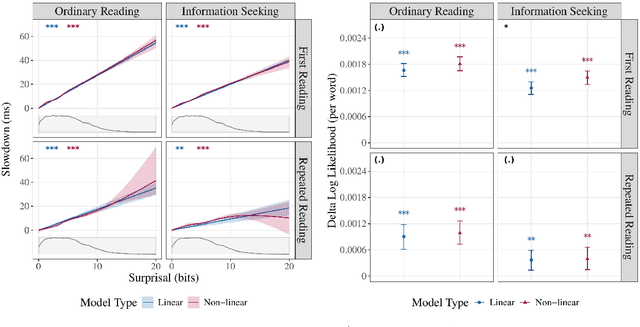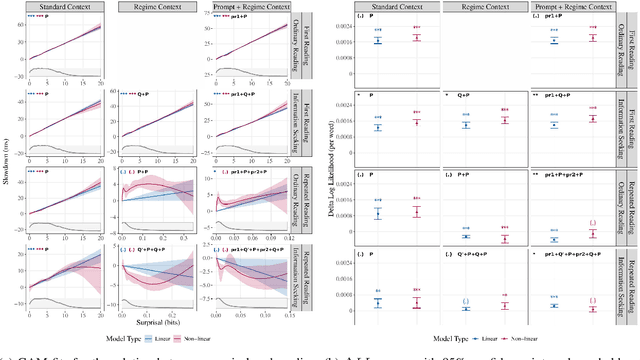Yoav Meiri
The Effect of Surprisal on Reading Times in Information Seeking and Repeated Reading
Oct 10, 2024


Abstract:The effect of surprisal on processing difficulty has been a central topic of investigation in psycholinguistics. Here, we use eyetracking data to examine three language processing regimes that are common in daily life but have not been addressed with respect to this question: information seeking, repeated processing, and the combination of the two. Using standard regime-agnostic surprisal estimates we find that the prediction of surprisal theory regarding the presence of a linear effect of surprisal on processing times, extends to these regimes. However, when using surprisal estimates from regime-specific contexts that match the contexts and tasks given to humans, we find that in information seeking, such estimates do not improve the predictive power of processing times compared to standard surprisals. Further, regime-specific contexts yield near zero surprisal estimates with no predictive power for processing times in repeated reading. These findings point to misalignments of task and memory representations between humans and current language models, and question the extent to which such models can be used for estimating cognitively relevant quantities. We further discuss theoretical challenges posed by these results.
Fine-Grained Prediction of Reading Comprehension from Eye Movements
Oct 06, 2024Abstract:Can human reading comprehension be assessed from eye movements in reading? In this work, we address this longstanding question using large-scale eyetracking data over textual materials that are geared towards behavioral analyses of reading comprehension. We focus on a fine-grained and largely unaddressed task of predicting reading comprehension from eye movements at the level of a single question over a passage. We tackle this task using three new multimodal language models, as well as a battery of prior models from the literature. We evaluate the models' ability to generalize to new textual items, new participants, and the combination of both, in two different reading regimes, ordinary reading and information seeking. The evaluations suggest that although the task is highly challenging, eye movements contain useful signals for fine-grained prediction of reading comprehension. Code and data will be made publicly available.
 Add to Chrome
Add to Chrome Add to Firefox
Add to Firefox Add to Edge
Add to Edge